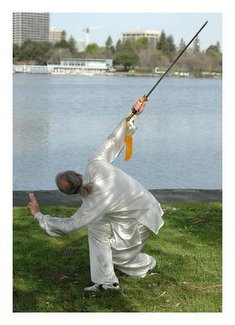TAI CHI CHUAN: SEEKING STILLNESS IN MOTION
It is becoming a more common sight in the San Francisco Bay Area: throngs of elderly Asians performing a softly fluid, slow-motion set of movements in tandem, all of them moving in a choreographic set of postures that is both soothing and graceful at the same time.
Anyone who has been to Golden Gate Park in the early morning, or in parks in Oakland has perhaps seen them. And this prompts the question: what is this mysterious set of calisthenics they are doing? Most people can answer: Tai Chi. But what is Tai Chi, exactly?
Tai Chi Chuan (alternately spelled Taijiquan) is an ancient exercise that combines the very best of the movement arts, Tuina (Taoist yoga), and Traditional Chinese medicine. Often many forms are composed of a certain set amount of movements (ergo, one will encounter numbers, such as the 24 Yang form, the 37 Cheng Man Ching form, the 36 Chen form, etc.) derived from a specific family legacy (Yang, Sun, Chen, Wu). And while some of these forms vary in appearance, they all carry the movements and principles that characterize Tai Chi.
Tai Chi Chuan is a method of meditation, self-defense, an opening of one’s acupressure points (called meridians), health maintenance, a way to improve one’s self awareness, a form of physical therapy (more Western doctors are prescribing Tai Chi not only for elderly patients, but for persons with back and heart problems), a path to spiritual enlightenment, and a relaxation technique, all rolled into one. It is suitable for everyone, regardless of age, body type, or fitness level.
The common misconception is that it is easy. The slow, languid movements one sees in its performance misleads the observer. It is primarily a mental discipline, geared toward seeking stillness in motion.
It is perhaps one of the most taxing disciplines one can pursue. The data overload from one class is difficult: often the newbie practitioner will be frustrated, not only at their inability to do the postures perfectly the first (or second, or even hundredth time), but also at the multiple mental principles required to even come close to doing the hand forms to a satisfactory degree.
But as any adult knows, anything that is worthwhile takes time and effort. As Thomas Paine once said, “That which we obtain too cheaply, we esteem too lightly.”
In other words: it takes work. And like all things in this life, what you put into it affects what you receive from it. Whether it is Tai Chi, or a career, any sort of exercise, the practice of anything important is, in short, an art form. Kung Fu literally translates to, “To have skill.” One can apply this to carpentry, to computer programming, to any interest, professional or simple hobby.
Because life is, in all its aspects, a work in progress.
So try, and see, if Tai Chi suits you. If not, then at least you’ve made the effort, and that is something in and of itself. If so, then you have a long road ahead of you, but one filled with numerous rewards, both mental and physical, and the growth potential for each individual in this art is exponential, contingent on effort made.
But it takes work.


2 Comments:
At 8:29 PM, Anonymous said…
Anonymous said…
So refreshing! I needed to read this! I'm glad that you have a Tai Chi blog up. I'm gonna add it to my blogroll most definitely! I can't wait for my Saturday class.
At 10:38 PM, Krystalline Apostate said…
Krystalline Apostate said…
Ocean lady:
Thanks, & welcome.
I hope to be providing more content very soon.
Appreciated.
Post a Comment
<< Home